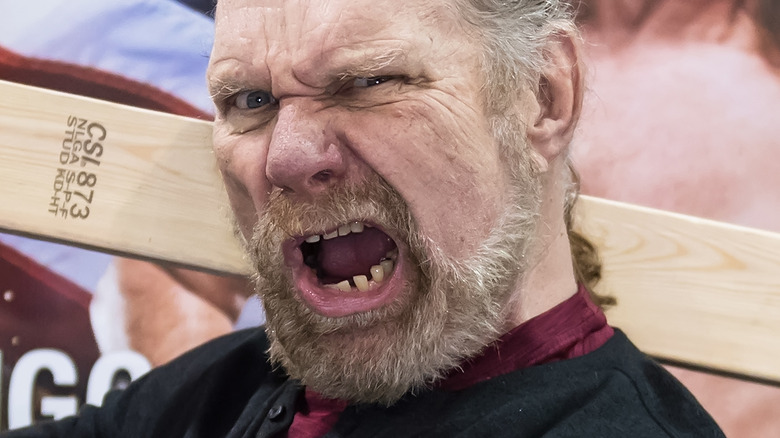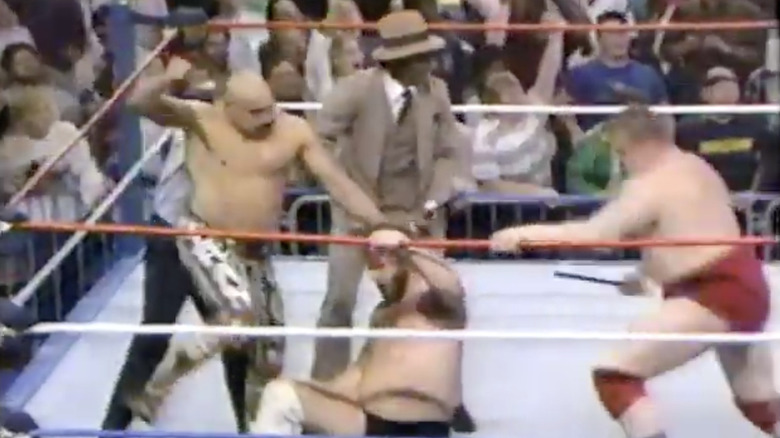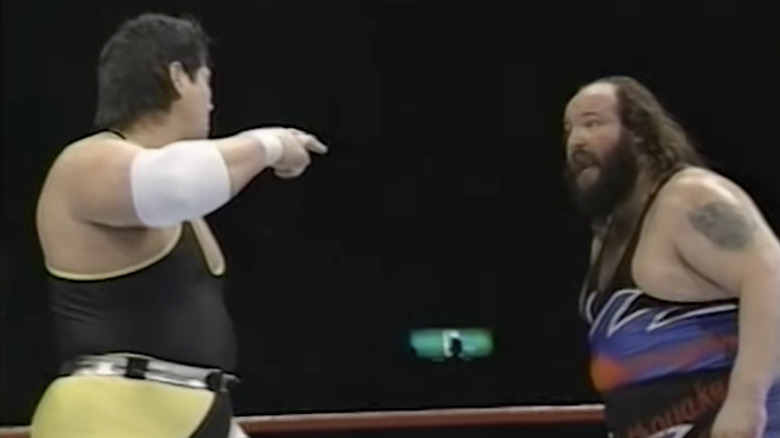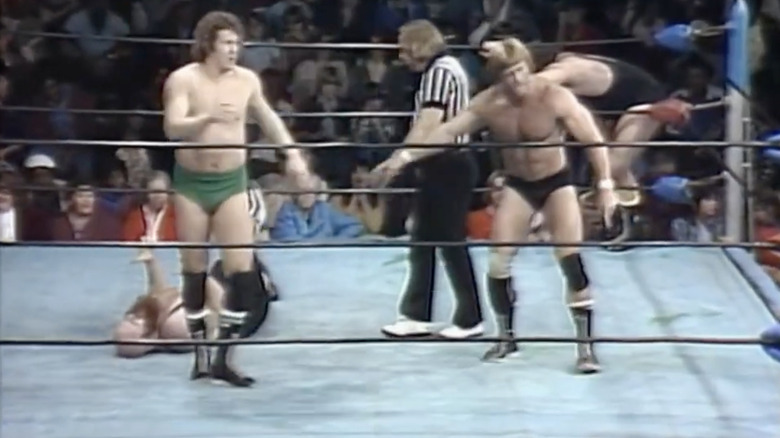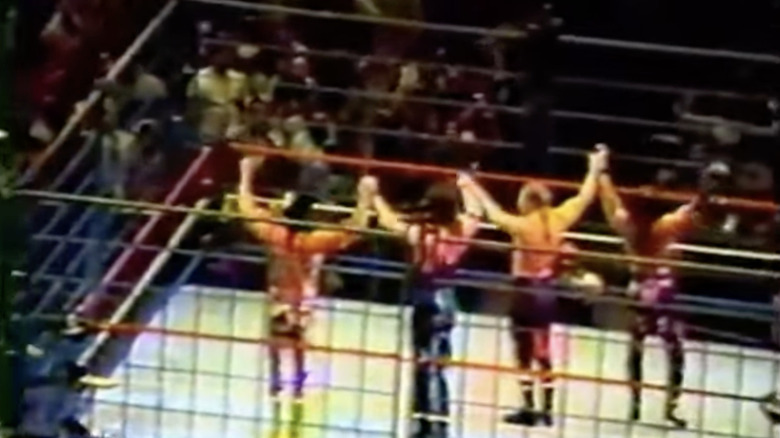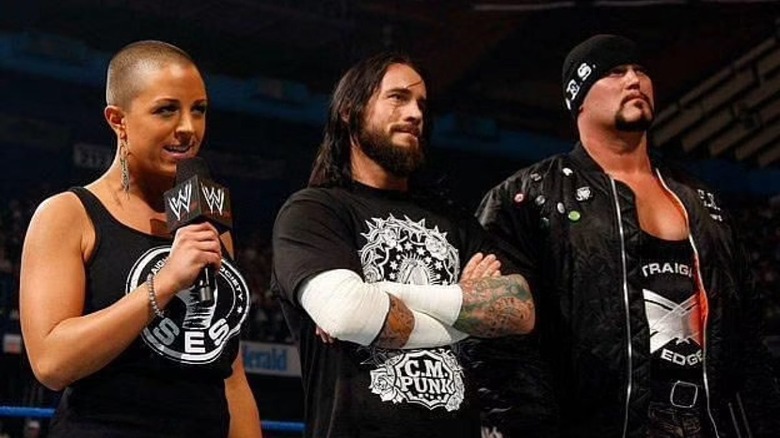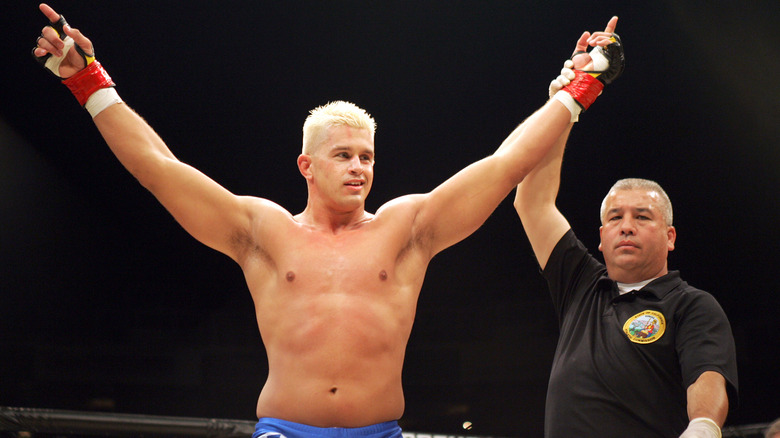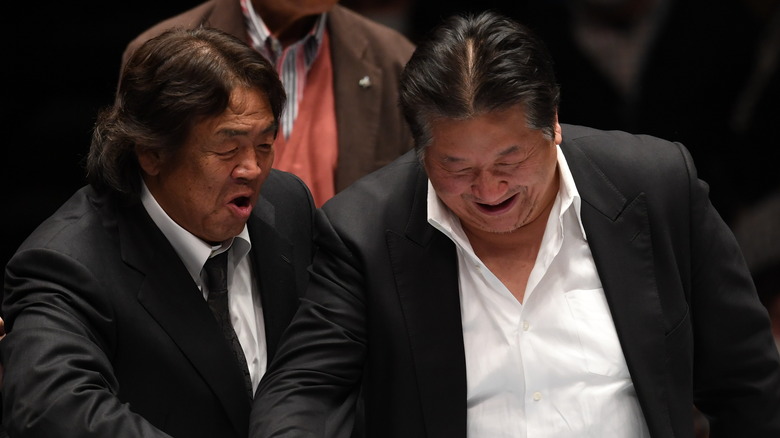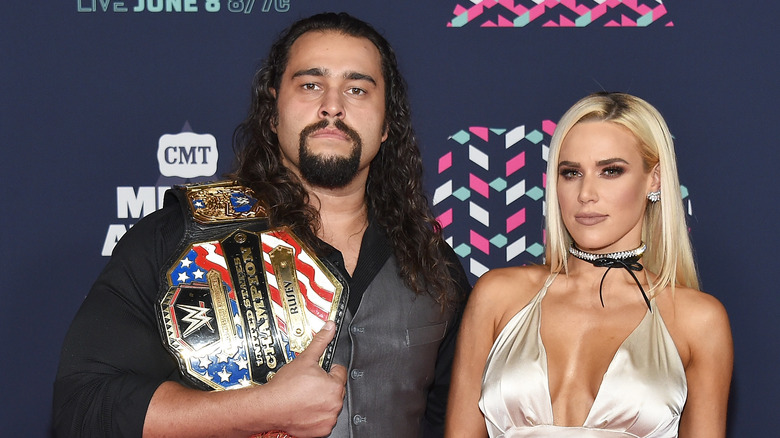Times Wrestlers Got In Trouble For Breaking Kayfabe
It's less of an issue than it's ever been, but for most of its existence, nothing was more sacred in the closed-off world of professional wrestling than "protecting the business" by obsessively keeping kayfabe, or keeping wrestling's secrets. Even if most people knew wrestling wasn't entirely on the level, it wasn't necessarily thrown in their faces, and enough spectators bought into it enough that heels regularly fell victim to fan violence. But even with "protecting the business" having consequences that included heels having to regularly avoid attempted stabbings, it was considered a cost of doing business that kept the fans more engaged and thus more willing to buy tickets.
As a result, when there were egregious violations, even well past the turn of the latest century if it was particularly over the line, the offending wrestlers would be punished by the promoters who they worked for. Sometimes, these were clear violations, like socializing with a hated onscreen rival or otherwise breaking character. Other times, they could get a lot more peculiar, like trying to bait the promotion into breaking kayfabe, losing a fight with a fan, or straight-up throwing a tantrum and yelling that pro wrestling was fake. So let's take a look at some of the most notable such punishments in wrestling history.
The Iron Sheik and Jim Duggan are arrested together on drug charges while feuding
In wrestling history, there are garden variety kayfabe violations, and then there's the 1987 arrest of "Hacksaw" Jim Duggan and The Iron Sheik in New Jersey..
"On May 26, 1987, we flew into Newark, New Jersey, for a show that night in Asbury Park," wrote Duggan in his memoir. "I was in the baggage claim area, waiting for my gear to come out on the conveyer [sic] belt, when the Iron Sheik walked up to me and said, 'Eh, Hacksaw, maybe I ride with you? I don't have credit card [to get a rental car].'" Being new to the WWF, Duggan didn't want to disrespect Sheik, who'd been in the company for years, so he agreed to ride together despite their ongoing feud on TV and being booked on opposite sides of that night's main event. That mistake was followed by accepting a beer from Sheik and leaving the open container visible as they drove past a state trooper. They were stopped, Duggan admitted to having cannabis in the car, and a search of Sheik found that he had three grams of cocaine on him, a felony amount.
They were released in time to make the show, but all hell broke loose. The story went national via the Associated Press, as the kayfabe violation made the news particularly juicy. Duggan, in his memoir, says both men were fired on the spot as soon as they each spoke to Vince McMahon. Duggan wouldn't be gone long, though: Houston promoter Paul Boesch invited him to work his WWF-affiliated retirement show on August 28. There, Duggan tore his hamstring when he failed to catch a Ted DiBiase kick as planned and took a bad step, but he gutted it out, finished the match, and earned his job back in the process. Sheik would return intermittently, but the arrest was the end of him as a real player.
Koji Kitao fired by SWS for saying wrestling is fake after he tried to shoot on John Tenta
Koji Kitao was grand champion in sumo as Futahaguro Kōji who turned to pro wrestling after being expelled from Japan's national sport in 1987 for abusive behavior that, according to a January 1988 New York Times article, included attacking and injuring his stable master's wife. He made his pro wrestling debut for NJPW on February 10, 1990 at the Tokyo Dome, but was gone within months. The October 8 Wrestling Observer Newsletter says he'd had "legitimate near fistfight in the dressing room" with booker Riki Choshu in July, with a 2021 Number article adding that Kitao made racist comments towards Choshu, who is of Korean descent. So he went to startup promotion SWS, which forged a working agreement with the WWF.
In SWS, he was booked against WWF rep "Earthquake" John Tenta, initially losing to him on March 30, 1991 at the Tokyo Dome, with the result to be repeated in a rematch two days later. Kitao wasn't happy about this, as Tenta was not a particularly accomplished sumo, with the Number article mentioning that SWS wrestlers had needled him about it, singling out veteran Don Arakawa as one of them. So when the match hit the ring, Kitao was uncooperative and vaguely threatening, with Tenta later telling Number's Gantz Horie that Kitao applying pressure in a Fujiwara Armbar was when he realized he had to cease cooperating himself. It turned into a standoff, which ended with Kitao kicking the referee to get disqualified before grabbing the house mic and making comments about pro wrestling being fake. Within days, Kitao was fired.
Bob Orton Jr. and/or Paul Orndorff fired for losing a bar fight
As the promoter of Mid-South Wrestling, Bill Watts was a bit different from his peers. The former college football and wrestling standout turned main event pro wrestler ran a tight shop in turns of discipline, regularly fining his talent, but it didn't stop there "I love the tough guys," he explained during the banquet luncheon portion of 1997's Eddie Gilbert Memorial Brawl. "And I only had two rules: If you got in a fight in my dressing room, we didn't break it up. I wanted to see who could whip whose ass, and then I'd book you back against each other to see if you'd want to do it again. Second thing: If you got in a fight in public, if you lost, you got fired." After all, how did it protect kayfabe to lose to a non-wrestler?
He then gave an example: "Ask Bobby Orton Jr. I looked at his knuckles, and there wasn't any bruises on 'em, I didn't think he'd thrown enough punches, and fired him." In a separate "shoot interview" in 2000, he didn't name Orton, but said the lack of bruised knuckles revealed the wrestler was "a catcher, not a hitter." The implication, seemingly, is that he knew Orton got into a fight and decided on his own that Orton must have lost. However, in another "shoot interview" from that era, with Jim Duggan, "Hacksaw" recalled the one wrestler fired under those circumstances as being Paul Orndorff after a fight in Arkadelphia, Arkansas, albeit in a situation where he was outnumbered.
It seems like it's agreed upon that someone got fired by Watts for losing a fight, the question is who and if they actually lost a (fair) fight.
Triple H loses his spot winning King of the Ring over the Kliq Curtain Call
In the spring of 1996, the WWF contracts of Razor Ramon (Scott Hall) and Diesel (Kevin Nash) were set to expire, with both electing to leave for WCW. As was customary, they put over other wrestlers on the way out, with Diesel in particular blowing off his feud with Shawn Michaels. Their last night in was a house show in front of a sellout crowd at Madison Square Garden in New York City, with Razor putting over Triple H on the undercard and Diesel putting over Michaels in a cage match main event. Where this starts to get complicated is that all four of those men, along with the then-injured 1-2-3 Kid (Sean Waltman) were collectively known as "The Kliq," a group of close knit friends known to wield their collective power. And so they did just that after the main event, flaunting that power by breaking character and celebrating together, all flashing what would become known as the Wolfpac/"Too Sweet" hand gesture at the fans.
Punishment had to be dealt for the flagrant kayfabe violation, but how? "Who was Vince McMahon going to discipline?" then-WWF creative team member Jim Cornette explained in an interview with Kayfabe Commentaries (transcription h/t Pro Wrestling Stories). "It was Kevin Nash's last night. It was Scott Hall's last night. Shawn Michaels was the champion. So Hunter Hearst Helmsley, who was supposed to win the King of the Ring, didn't win the King of the Ring. Cost him about a hundred to a hundred fifty thousand dollars that year. Probably what he would have made and what he didn't make. He was punished because he went along with the other three f*****g guys." Instead, Steve Austin won King of the Ring that year, and the rest was history.
Serena Deeb fired for not living her straight edge gimmick in public
If you've paid close attention to the commentary during Serena Deeb's matches in AEW, then you may have noticed that her specially named signature moves have a theme to them: The Deebtox (as in "detox") and the Serenity Lock (as in the Serenity Prayer), both references to substance abuse addiction and recovery. Deeb has been open publicly about being a recovering alcoholic, and clearly takes pride in her the strides she's made, to the point that she's worked her history into her in-ring persona. Before she was open about her struggles with alcoholism, though, her addiction cost her a full-time job in pro wrestling under unusual circumstances.
In January 2010, Deeb was called up to WWE's main roster as a member of CM Punk's Straight Edge Society stable, which was clearly framed as having cult-like vibes but never explicitly referred to as such. That the character was explicitly an addict appears to be a coincidence, as Dave Meltzer reported in the August 30, 2010 Wrestling Observer Newsletter that she got the role because she "jumped at the chance to get her head shaved in an angle" when other women refused. Regardless, the gimmick was what it was, which meant keeping up appearances in public. Per that same Observer, she was fired on August 20 for "not living the gimmick" of a teetotaler — apparently that she was drinking in front of fans according to Cageside Seats — and a July angle where she was caught drinking on a security camera "was meant as a metaphor and a message about a potential issue."
In other words, not only was it an egregious kayfabe violation to do it in public in front of fans, but it was seen as a red flag that she didn't have the self-control to drink somewhere else.
Daniel Puder endures a chopfest for putting Kurt Angle in a legitimate double wristlock
Season 4 of WWE's "Tough Enough" was a departure, a series of weekly segments on "SmackDown" instead of a standalone reality competition show, but with the same prize: A WWE contract. For the show that aired on November 4, 2004, it got particularly stunt-y, with the contestants having an eating contest filed by the intense exercise of a squat thrust competition ... with the winner facing Kurt Angle. In a legitimate wrestling match.
Chris Nawrocki "won" the squat thrust challenge, which, according to the November 15 Wrestling Observer Newsletter, was because the referees were told to get rid of "the blond guy," not considering that both he and MMA fighter Daniel Puder were blonds. Angle guzzled Nawrocki in seconds, then challenged Puder ... who locked him in a double wristlock/Kimura and cranked it until, per the Observer, producer Gerald Brisco told referee Jimmy Korderas to count Puder's shoulders down. Angle told Puder off after, claiming it was under amateur wrestling rules, but it clearly wasn't, as Nawrocki got a rope break, they used a three count for pins, and Puder had asked the referees if submission holds were allowed. He made the canonical toughest man in WWE look uniquely mortal, and that was a problem.
By 2004 standards, it went viral, carrying Puder to being crowned the winner of the season. For his trouble, he was entered in the 2005 Royal Rumble, where Chris Benoit, Eddie Guerrero, and Bob Holly all proceeded to chop the hell out of him in some sort of very wrestling-y punishment ritual. "That was a different time and how they treated young talent that they felt maybe shouldn't be getting a certain push and shouldn't be paid a certain price and the whole Kurt Angle thing," former WWE writer Court Bauer told Fightful in 2021. "So, there was a real old school undercurrent to the Smackdown locker room."
Akira Maeda almost gets sent to North America for shooting on Riki Choshu and trying to force NJPW to break kayfabe
By late 1987, Akira Maeda had already built up a unique legacy in his then nine-year career as a pro wrestler. He went from being groomed as the next big thing in New Japan Pro-Wrestling to walking out on the company, becoming one of the founding roster members of the original Universal Wrestling Federation in 1984, and then things got weird. He had a pair of matches that turned real in back to back years, first against Satoru Sayama in 1985 (where it ended when he legitimately kneed Sayama in the groin) and then a bizarre standoff with Andre the Giant after he returned to NJPW in 1986. So it wasn't exactly out of character when he hauled off and kicked Riki Choshu in the face full force from his blind spot in a November 19, 1987 trios match. Maeda had to be punished. But how?
"This incident created a major public relations problem for New Japan," explained Dave Meltzer in the December 21, 1987 issue of the Wrestling Observer Newsletter. "[H]ow can you explain suspending someone for a kick to the face when in every match, wrestlers kick to the face[?]" The best summation of what happened next comes from a Maeda bio in the July 27, 1998 Observer that was written to commemorate his retirement. "New Japan had no choice but to suspend Maeda for the rest of the year but somehow in all of this Maeda came out of it as the hero," wrote Meltzer. NJPW was willing to bring Maeda back, but only if went on a tour of North America that included doing lucha libre in Mexico, "cruel and unusual punishment for a guy whose reputation was based on realistic wrestling," and put over Choshu when he returned. Instead, he started the second UWF.
Lana gets taken off TV when her engagement photos leak to TMZ
Here's a particularly modern example: In October 2015, TMZ broke the exclusive story, complete with photos, that WWE's Lana and Rusev (AEW's Miro) had gotten engaged. Citing "sources close to the couple," TMZ reported that Miro had proposed to C.J. Perry, the real person behind the Lana gimmick, in the swimming pool of their Nashville, Tennessee home. This caused some problems, though, because at the time, their storyline on TV was that they had split up, with Lana pairing off with Dolph Ziggler and Rusev pairing off with Summer Rae. The engagement going public resulted in that storyline being hastily ended via a WWE.com article that quoted "Lana" extensively. That wasn't the end of the drama, though, because WWE soon pulled her from TV as punishment.
"I didn't even put up a picture, I just sent it to my friends," she told Chris Jericho on his "Talk Is Jericho" podcast in July 2021 (transcription h/t WrestleTalk). "And then I guess someone leaked it. I never, ever put it up. TMZ got a hold of it ... I got in trouble for that. I wasn't on television for three months. And I was on television straight for two years. I was made to feel it was all my fault. I had to take the blame. And for years I thought maybe it was my fault. For years. And then we did the Bobby Lashley story and I had given Vince my word that I would not take a picture with someone I am feuding with, or send it to anyone. If I take it it's not leaving my phone. And I gave him my word that I'm not going to do that anymore. So my word is all that I have."
